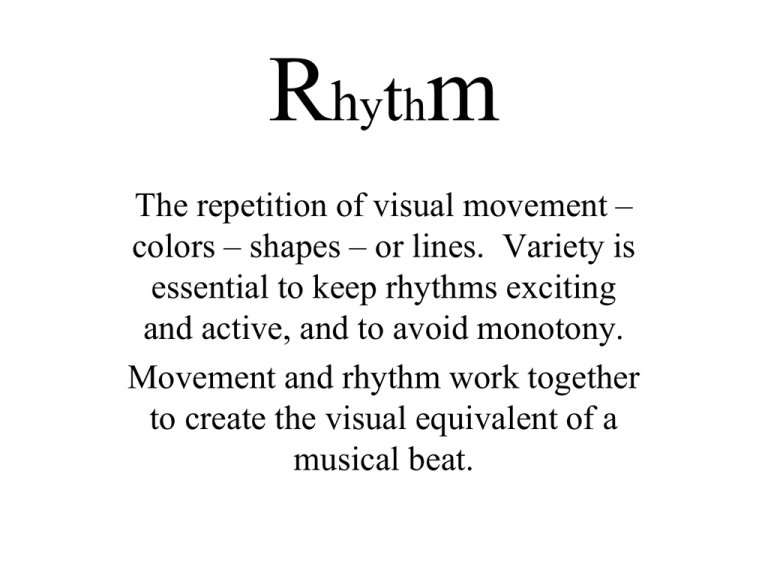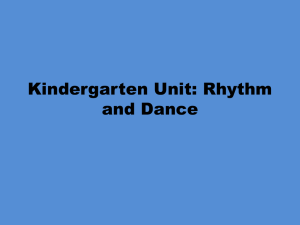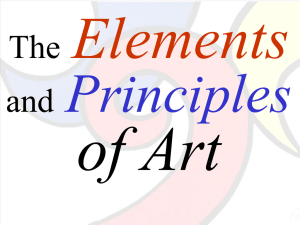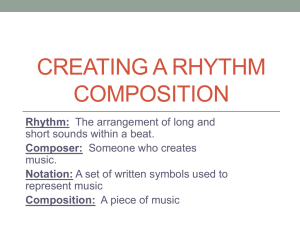Rhythm
advertisement

Rhythm The repetition of visual movement – colors – shapes – or lines. Variety is essential to keep rhythms exciting and active, and to avoid monotony. Movement and rhythm work together to create the visual equivalent of a musical beat. Dum, Dum, Dum, Dum • Rhythm is a basic part of life. Think of heartbeats, music, walking, dancing, or breathing. Rhythm as a design principle is based on repetition of colors, shapes, forms, lines or value contrasts. Developing rhythm in a work of art will help unify the surface and create a pleasant feeling of planned organization. Architects Use Rhythm • Architects repeat shapes of windows, columns, arches, or other details to unify the appearance of their building. Several such repetitions or rhythms are seen in the United States capitol building. Unifying the Look • The rhythmic sequence of columns, and other architectural details were used to unify this Greek architecture. Regular Rhythms are planned. • Regular Rhythm is planned by an artist, craftsperson, or builder. The vertical boards in picket fences create regular rhythms because the boards sizes and spacing are the same. They rise and fall in a regular rhythm, just like notes in a song. Regular Rhythms May Have Variety • Regular rhythms may have variety and need not be repeated exactly. Although the nine chickens seem to look alike, each is a little different in shapes and placement. Some are higher, some are lower. Variety provides interest. Planned Repetition turns into Regular Visual Rhythm • Any planned repetition will produce regular visual rhythm. • Ceramic artists often decorate their glazed surfaces with regularly repeated elements to create rhythm. Craftspeople and Rhythm • The repeated shapes, colors, and lines in this very detailed pot created by native American Efren Ledezma not only causes the eye to sweep over the pot, it causes it to have a visual rhythm or beat. Patterns – Movement - Rhythm • The patterns on his vases, are what makes his work not only have movement, but also rhythm. • You can see in the view from the top how the lines undulate back and forth, like waves in the ocean. • Regular rhythm is the repetition of elements that are the same or nearly the same in regular sequence. They have variety in that they all look a little different in shape. The pop cans create a rhythm. They are in rows, but go up and down with size, like notes on a music scale, while the cloth that they are laying on has a pattern. The difference between Rhythm and Pattern? • These pop cans are in rows too, and on a shelf which has a pattern, but they are not nearly as interesting as the previous image. The notes* stay the same, and are stagnate and monotonous. • The variety of the shapes added rhythm and interest to the previous image. Flowing Rhythms • You can easily see the flowing rhythm in this ceramic plate. • The top row of cups is a regular rhythm, boring and stagnate. • The bottom row is an irregular rhythm, which has more interest because of variety. Regular vs Irregular • A row of evenly spaced trees or rocks, like in the top image, create a regular rhythm. • In the bottom image, the trees are spaced unevenly so they create an irregular rhythm. Staccato Rhythms over patterns • Rhythm in art, as in music, may change from one work to another. Here, staccato repetitions seem like quick bursts of energy and are placed over a regular horizontal pattern. • Staccato Rhythms are repetitions that are abrupt and that change frequently. Irregular Rhythms In Nature • Irregular Rhythms are often seen in nature because trees and flowers are not planned by a gardener. More Irregular Rhythm • A city’s skyline is also irregular because buildings and spaces are different. Rhythm is based on repetition • Rhythm as a design principle is based on repetition of colors, shapes, forms, lines or value contrasts. • The shapes of the buildings are different, but the same in that they are tall skyscrapers. • They all have different patterns on them. • Another artists interpretation of a cityscape using irregular rhythm. More Irregular Rhythms Watercolor, 18 x 28 in • Irregular or unplanned rhythms are formed by waves and sloshing water. In the painting by Mary Alice Braukman, Waves and Rocks, the flowing rhythms are unplanned and are not repeated exactly throughout the painting. • Irregular rhythms might repeat throughout a painting without any exact duplication. Robert Delaunay & Orphism • • • • Painting complementary colors opposite one another, revolutionary French artist Robert Delaunay exuberantly conveyed life’s delights and complexities in “Rhythm, Joie de Vivre.” Delaunay (1885 – 1941) was originally a theater set painter who later employed Cubist theories to explore contrasting colors. Cubists used geometric cubes and shapes in their works. Delaunay’s talent emerged rapidly, and he began exhibiting only a year after he started painting. His unique style sparked Orphism, which expressed an object’s movement, light and rhythm, rather than its physical form. Delaunay’s art also incorporated wax, sand, mosaics and lacquered stone, and powerfully influenced the development of abstract art in the 1920s. • The City of Paris, Robert Delaunay, 1913 • In The City of Paris, you can see the cubists influence. • Rhythms are created with colors and shapes. • The figure seems to rotate on the canvas. • Eiffel Tower“, Robert Delaunay, 1924. • The use of lines, colors and shapes were used to create flowing upward rhythms in this painting. Progressive Rhythm • Progressive rhythms are those in which the elements change sizes as they progress or move across space. This is seen in looking at buildings or a fence in perspective. The windows and architectural elements are the same size, but diminish as they progress into space. Marcel Duchamp & Rhythm • Marcel Duchamp (dooshanh) painted Nude Descending A Staircase to show the rhythmic movement of a figure coming down stairs. • The effect is like stopaction or strobe-light photography, because the repeated shapes and angles of the abstracted figure move diagonally across the canvas. • Try to feel the rhythm the next time you walk down some stairs. Up Close • Repeated head shapes are not exactly alike, but the variety provides interest. • Repeated hip shapes follow the diagonal movements down the stairs. • Repeated leg movements dictate the rhythm of an abstract figure descending stairs. Both shapes and lines are used by the artist to develop the rhythm. • Value Contrast between positive and negative shapes places emphasis on the fractured, rhythmic figure. • We see the figure because the background is dark and the figure is light in value. What we have learned • Rhythm is the • Movement and repetition of visual Rhythm work movement using: together to create the colors, lines, or visual equivalent of a shapes. musical beat. • Variety is essential to • Developing rhythm keep rhythms exciting will help unify the and active, and to work and create a avoid monotony. feeling of planned organization. • Regular rhythms may have variety and need not be repeated exactly. • Variety provides interest. • Any planned repetition will produce regular visual rhythm. • Like pattern, rhythms can be regular or irregular. • Progressive rhythms have elements that change sizes as they go back in space.






